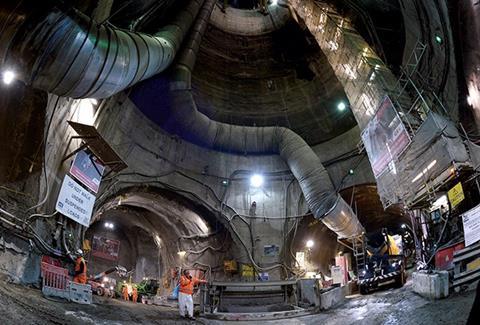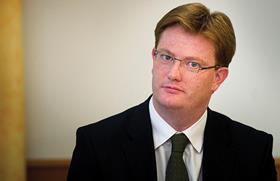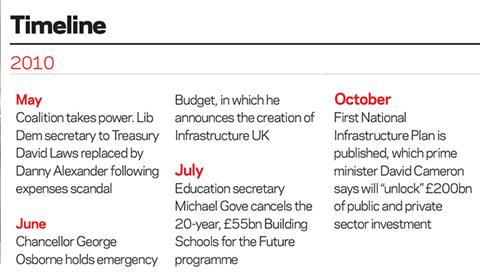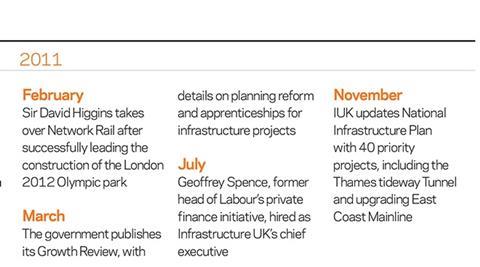Continuing our series looking at construction from inside the corridors of power in the run-up to the election, Mark Leftly asks if the coalition’s track record on infrastructure is anything to celebrate


Tucked 15 miles to the south of tourist-friendly Isle of Mull and just north of whisky lovers’ paradise Islay, lies Colonsay, population 124. This tiny island boasts a hotel, an 18-hole golf course and even a micro-brewery, but when Danny Alexander was a small child growing up there in the seventies it was better known for an abundance of mackerel - and not having mains electricity.
“The generators caught fire often,” says a close colleague of Alexander, who, four decades on, is one of the most powerful members of the coalition as chief secretary to the Treasury. “You have to remember that family background: he’s seen in a very real way what infrastructure can do to help people take part in society.”

Alexander (pictured) leads the government’s infrastructure strategy, chairing the Cabinet’s sub-committee, but believes that the Tories are getting the credit for his work. “If there was an Advertising Standards Agency for politics we’d try and do the Conservatives,” says a party spokesperson.
For their part, the Tories point out that Alexander has his own place on “the grid” during the Treasury’s annual set-pieces, the Budget and the Autumn Statement. The 42-year-old potter’s son gets a day, usually to announce major infrastructure initiatives, before or after chancellor George Osborne makes the main speech to the House of Commons.
But, with the general election just over six weeks away, it is questionable whether either party should want to claim responsibility for infrastructure. Certainly, Office for National Statistics data suggests that the coalition has failed to meet Nick Clegg’s pledge for a “gear shift” to get government money to major projects. The value of construction output from infrastructure work stood at more than £14bn in the year the coalition took power, rising to a 15-year high of £15.3bn the year after on the back of the leftover of Labour’s fiscal stimulus and the start of Crossrail works in earnest. However, since then output has been slowly falling, reducing to £13.3bn by last year. So what is the coalition’s real track record?
A year of mayhem
Stark figures might not be a fair measure of the coalition’s performance. A Number 11 source points out that its first year was dominated by “fiscal events, getting the books back in order” as the worst global downturn since the 1930s hit hard.
Big projects were, inevitably, more likely to be pulled than supported. Two months after taking power, education secretary Michael Gove scrapped the £55bn Building Schools for the Future (BSF) programme, ending head teachers’ hopes for more than 700 shiny new facilities. This was the most obvious sign of a major shift away from so-called “social infrastructure” such as schools and hospitals, toward “economic infrastructure” - roads, railways, power stations - that is seen as bolstering the UK’s economic competitiveness Richard Threlfall, KPMG’s head of infrastructure, argues that BSF’s cancellation was just one part of a “year of mayhem” that “exacerbated the industry’s problems”.
But he says the coalition has subsequently avoided the internal bust-ups seen in other areas, such as tuition fees. Ministers have co-operated over High Speed Two (see box, overleaf), despite opposition from within their own parties and, says Threlfall, have come up with “interesting schemes that no one had ever heard of before, like HS3”.
Plans for this Leeds-to-Manchester link were first announced in the autumn as part of Osborne’s push to create a “northern powerhouse” and rebalance the economy from its over-dependence on the South-east. That the coalition has gone from halting projects like the £1.1bn A14 road-widening scheme in its first weeks, to proposing a £7bn follow-up to the most controversial railway in Britain’s history, shows how far infrastructure has risen up the political agenda since 2010.
There were some very lofty ambitions but they weren’t followed through
Chris Leslie, Labour
Yet even when he first took office, Osborne realised that infrastructure would be instrumental to the recovery once he had dealt with the immediate problem of reining back departmental budgets.
Building understands that in his first week as chancellor, Osborne rescued Crossrail 2, the £20bn Hertfordshire-to-Surrey proposal that will run under London. This was a nascent plan for a sequel to the £15bn Berkshire-to-Essex Crossrail, now Europe’s biggest civil engineering project.
As Crossrail 2 was far into the future, Treasury mandarins included it on what the Number 11 source calls a “politically attractive” list of projects to cancel as part of the coalition’s pledged austerity drive. Osborne, though, believed that Crossrail 2 was needed to support the capital’s predicted 20% population growth by 2030. “George said ‘No way, that’s exactly what we should be working on’,” says the source. “It [terminating a costly major project] was an institutionalised, Treasury way of thinking.”
Man with a plan
An early hint of Osborne’s infrastructure ambitions came in his first Budget with the establishment of a specialist unit in the Treasury. Chaired by the amiable City grandee Paul Skinner, Infrastructure UK (IUK) was to draw up the country’s first ever National Infrastructure Plan (NIP).
More of a vision sketching out Britain’s broad infrastructure requirements, this was redrafted the following year under new chief executive Geoffrey Spence, so that it focused on 40 priority schemes. A no-nonsense former adviser to Alistair Darling, Spence has annoyed a fair few in the industry - “abrupt, peremptory,” says one Whitehall source - but has been praised for getting the NIP into shape.
The 2011 NIP was accused of being a mere collection of projects, which were either under way already, like work on the M25, or accompanied by little detail on how they would be financed. Revised annually, by 2014 the NIP was far more detailed, and one former fierce critic says: “It now looks halfway decent, not just an unfunded wish-list.”
Strapped for cash, and with the Organisation for Economic Co-operation and Development warning the UK could slip back into recession, Osborne announced a plan to get £20bn of infrastructure investment from British pension funds. It was envisaged that much of this would go into those priority projects, even though experts pointed out that risk-averse pension funds would not invest in infrastructure at the construction stage - so-called “Greenfield” infrastructure, in the terminology the funds use - as construction carries significant risks.
Sudden client design changes, legal disputes and historical asbestos problems in redevelopment increase the risk of investment losses as a project is being built. Pension funds don’t need high returns, but they do need virtually guaranteed income streams to meet their liabilities.
Fast forward a year, and the National Association of Pension Funds finally agreed to develop a scheme to pool £2bn of the industry’s money - just a tenth of the initial target - into a dedicated infrastructure fund. But even attracting that capital has proved an almighty struggle, and it has raised only £350m from pension funds so far.
Similarly, Vince Cable’s much-trumpeted Green Investment Bank, set up to plough money into environment-friendly projects like wind farms and biomass facilities, has invested only £2bn since 2012. This could have been far greater, but the bank lacks borrowing powers. Osborne promised to give it these powers by 2015-16, but there was no announcement in this week’s Budget and for the moment, it still relies on Treasury funding. Bank chief executive Shaun Kingsbury has been calling for the power to raise debt to be accelerated for two years now, but his repeated requests have been turned down. “It’s been straitjacketed,” says a senior infrastructure consultant.
“There were some very lofty ambitions, but they weren’t followed through,” says Chris Leslie, the shadow chief secretary to the Treasury. “We were quite happy to give cross-party support [to the ambitions], but delivery slipped.”
Treasury: Help or hindrance?
Aware progress was painfully slow, the government launched a £40bn UK Guarantee Scheme three years ago that effectively underwrites credible projects that are struggling to secure finance because of the risks inherent in construction. At a time when the credit markets were in a dire state, the sovereign-backed guarantee was designed to give private lenders confidence that they would get their money back if the project failed, so they would offer low rates.
But in January this year, the National Audit Office found IUK, despite receiving more than 200 enquiries, had only guaranteed eight projects worth a total of £1.74bn, including a £257m bond for the Mersey Gateway toll bridge.
Labour’s Leslie says: “The coalition has been very good at putting out press releases, and the main thing they purported to be different was the use of government guarantees to underwrite infrastructure development - yet little more than £1.5bn has been deployed, which is frustrating. There is too much jumping through hoops to access the scheme.”
Although there were 39 projects that were in the pre-qualifying process for a guarantee, the scheme seems to have struggled to meet its main objective of ensuring that projects were not stalled by a lack of money.
The NAO report pointed out that Treasury due diligence found concerns that projects were “poorly structured” commercially, and some were far too early to assess given that they might not even have planning permission. But a Whitehall source argues that the more fundamental problem is that IUK sits inside the Treasury, which is “not a delivery department”. In other words, Treasury officials are used to cutting costs prior to pushing ahead with other department’s projects, and is not itself geared towards building infrastructure.
The source argues that this problem manifested itself in the drawn-out negotiations over Hinkley Point C in Somerset, which would provide about 7% of the country’s electricity and is supposed to herald a new era in nuclear energy.
At one point Hinkley’s new reactors were supposed to start work by 2019, but 2023 is the current target. Energy department officials were negotiating with operator EDF over a strike price - a guaranteed minimum fee for electricity, vital if the French group was to risk pouring billions into this single plant.
In 2012, they were close to a strike price between £95 and £99.50 per MWh, according to energy department sources. However, Osborne was increasingly impressed by the potential for far cheaper shale gas and started pushing for an unviable £80 per MWh. “Having two separate negotiating teams is not a good idea,” says one source. “It was more political in IUK - they thought ‘if gas is so cheap, why not burn gas?’ - until the penny finally dropped that they can’t just have one energy source, and they wouldn’t meet EU carbon reduction requirements without nuclear.”
The price was finally agreed at £92.50 in late 2013, which, depending on the department a civil servant works for, is regarded as either a false economy given the delay or a good result for the taxpayer that resulted from Treasury pressure. Those delays continue, though, as private warnings by former energy minister Michael Fallon that anti-nuclear Austria would challenge the UK for unfairly skewing the energy market through the strike price have subsequently come to pass.
The painfully slow-moving nature of this project is rather typical of the coalition’s record on infrastructure. Alexander (pictured, left) and Osborne share an almost Victorian passion for grand infrastructure, the former as he remembers his disconnected childhood, the latter as he looks to rebuild the economy on the foundations he has laid.
The projects they so love, from Hinkley to Crossrail 2, are grand and their policies, such as the guarantee scheme, are innovative. But on the ground, infrastructure has yet to pick up - and, even in the wake of the financial crisis, delivery is what their record will be judged on.






HS2: IS IT WORTH IT?

Canny politician that he is, Ed Balls gave Ed Miliband, an option to take advantage of public opposition to HS2 if Labour faltered ahead of the general election. In a 2013 speech, the shadow chancellor said: “The question is not whether a new high speed line is a good idea or a bad idea, but whether it is the best way to spend £50bn for the future of our country.”
Hopes for HS2 were fading at the time: there was dismay that the cost of the London-to-Birmingham first phase had been underestimated; growing fears of environmental blight; and an ill-judged emphasis on cutting journey times rather than tackling an under-capacity crisis on the railways, which are at their busiest since the 1920s. Opposition has cooled under the leadership of Sir David Higgins, who became chairman after Doug Oakervee, who was better known as “Captain Invisible” by some of those involved in HS2, left at the end of 2013. The former Olympic Delivery Authority boss is so well regarded that even Public Accounts Committee chair Margaret Hodge who is sceptical of HS2’s benefits, did not challenge his appointment, despite concerns it may have flouted civil service rules.
If there was still the same level of hostility to HS2 that existed two years ago, Balls might well be pushing Miliband to place scrapping the project front-and-centre of Labour’s manifesto. As it is, a shadow cabinet member says the pair have come to a “settlement”, which seems to mean backing phase one. With little political gain, it was not worth risking an internal row with Lord Adonis, the shadow infrastructure minister who is credited with originally thinking up HS2. But Balls is also sympathetic to the likes of former chancellor Alistair Darling, who worries the cost is too great for a single railway. If Labour takes power, Michael Dugher, who holds the transport brief, and the Treasury will undertake a cost review of the Y-shaped second phase, reaching Manchester and Leeds from Birmingham. Billions could be taken out of phase two and spent on other rail projects. That might even be sufficient to make phase two unviable. A cosy cross-party consensus is more likely to be broken in the aftermath than in the run-up to a general election.
Mark Leftly covers politics for The Independent on Sunday and is associate business editor across the Independent newspapers and the London Evening Standard




























No comments yet